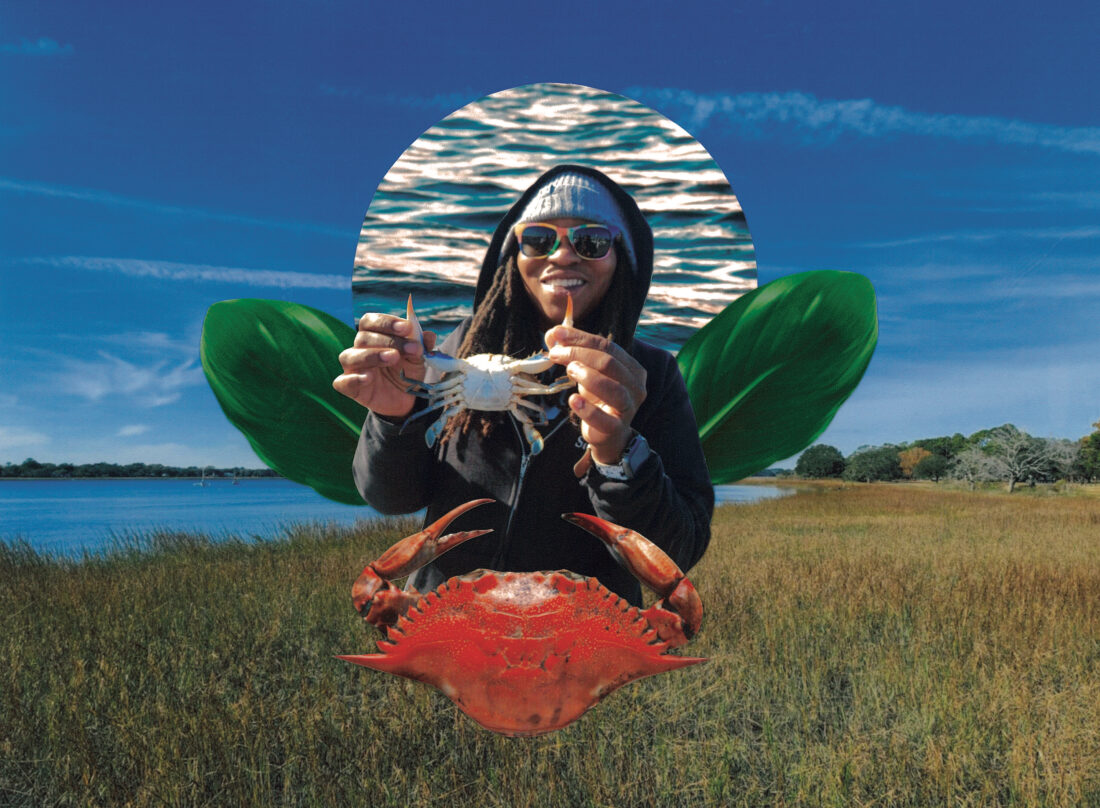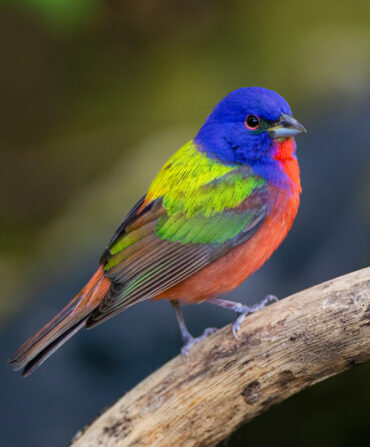A confession: I have lived in the coastal state of South Carolina most of my life but harbor a deep aversion to seafood.
As an Upstate dweller, I rarely ran across shellfish and other marine life. My parents constantly worked to make ends meet, so vacations to the beach were unheard-of. I saw the ocean for the first time at age eleven; I would not make my way back to the water’s edge again until I was seventeen, and then not for a decade later.
My seafood avoidance wasn’t about taste, though, but fear. As the daughter of a farmer and avid fisherman, I have no issue coming face-to-face with my intended dinner. The mantra of catch, clean, and cook might as well be tattooed on my forehead. But my family’s tall tales kept me from indulging in the delicacy the rest of them salivated for: Callinectes sapidus, which translates to “beautiful savory swimmer,” otherwise known as the Atlantic blue crab.
Those myths circulated during gatherings at my great-aunt Gladys’s house in Columbia. Gladys, a firm, deeply religious woman, cherished family, and our arrival triggered celebrations with dishes of jubilee, including, occasionally, fresh seafood. I still recall the round wooden crates arriving from the coast, stuffed with ice and living crabs feisty enough to climb out and face off with the adults, front claws tilted toward the ceiling. From the safety of my play area, I peered toward the stove and the speckled blue stockpot emitting steam, where soon the hostile crabs would find themselves in hot water. To keep children like me away from the crustaceans, the adults told us a tale about a shriveled gray section of the crab they called “dead man’s fingers.” The “fingers,” they said, were poisonous; they would strike us dead if we got a taste. It wasn’t hard to believe; to my seven-year-old self, those crab parts looked just like the shriveled fingers of the corpse who hosted the HBO series Tales from the Crypt.
Now I understand that my family fibbed to make sure the children left the crabs to them. This winter, I decided thirty years of intimidation was enough—it was time to better understand the pastime that fed my ancestors and enchants my coastal friends. That’s how I find myself on the end of a dock along the Ashley River for an early morning meeting with Tia Clark, who runs Casual Crabbing with Tia in Charleston.
Clark grew up on the peninsula, but logistically, the area’s beaches felt a world away, and she only began crabbing as an adult as a way to get some exercise and to escape the pressures of her career in the hospitality industry. Then she loved it so much she quit her job, and for the past five years, she has spent every waking moment on the water, teaching others how to crab and better understand the briny depths.
I tell her of my folktale-based fears and my anxieties about being pinched—I’m a writer, after all, and I’d prefer to keep all my fingers. So she first shows me how to handle a crab properly, fingers on the carapace, well behind the claws. We then start with an old crabbing technique called “necking.” All it takes is a ball of twine, a tasty morsel tied to the end of the line (in this case, a piece of chicken), time for a crab to discover your offering after you sink it into the water, and a net to scoop up your target. When I feel a tug, Clark instructs me to slowly bring up the line, the wet twine scraping against the tops of my shoes. Crabbing this way is an exercise in patience, a challenge for someone whose motto is “Instant gratification takes too long.” I don’t mind being bad at it; I’m just thrilled to be out there with Tia and Art Perry, who cohosts the outings, standing on the edge of the dock, watching the tide ebb and flow.
After that, I try my hand at throwing a cast net but don’t catch much of anything: a palm-sized silver perch, a small shrimp, an empty shell or two. No matter, I am entranced—by the rhythm of being in conversation with the water, by the elegance of the casting movement. The physical poetry of raised arms, the sweep of white that spreads just before the arc, and at the end, the satisfying slap as the net settles into the water and sinks.
When we finish, I have a half bushel of blue crabs for my trouble. Clark demonstrates how to clean them, and I take the bunch to Charleston Crab House, where they will steam your catch, for a price. I try my first cooked crab while staring out at Wappoo Creek. The crab meat is flaky, salty, sweet. But the amount of labor involved, even with the aid of a cocktail fork, and my lack of dexterity mean I can’t crack enough to satiate myself, and the whole exercise leaves me frustrated. I have the privilege of ordering something else from the restaurant menu. My ancestors didn’t.
In fact, they’re why I pushed myself to go crabbing; before moving to the interior of South Carolina, my forebears were enslaved along the coast. Back then catching the abundant blue crabs helped them survive. These days, crab numbers tell a different story. Once considered a sustainable, renewable, accessible food source, crabs are now buckling under environmental and human pressures such as large storms, warming waters, habitat loss, irregular weather patterns, pollution, and overharvesting. The sociological, ecological, and economic role blue crabs play on the coast is now in jeopardy. In recent years, Southern fisheries have reported drops in populations of more than 20 percent; North Carolina, for instance, has instituted new measures to boost sustainability, including limits on seasons, catch sizes, and bycatch.
Out on the dock with Clark, out of breath, back tight, I better understand the fulfillment that trying to catch, clean, and cook my dinner brings. Clark deeply believes in the power of those efforts too, but she adds one more c: conserve. Time on the water, she says, saved her life. She wants to make sure generations to come can fish and find renewal at the water’s edge, too. If we’re going to take from the environment, we also need to contribute to its survival.
A couple of days later, I join Clark to see how she translates that ethos into action. She, her work crew, and a group of volunteers have gathered to build shoreline restoration cages with South Carolina Oyster Recycling and Enhancement (SCORE). SCORE collects oyster shells from Charleston restaurants, and at least once a month, Clark’s group comes to a site on James Island to fill cages, sometimes repurposed from old crab traps, with the shells and coconut fiber to create a viable habitat for oyster larvae and other sea life.
The program plants the artificial reefs in estuaries where coastal erosion threatens the marine environment, including along the pier where Clark takes people crabbing. She’s seen the difference the method makes, even on land. The grass, which once retreated toward the road, has returned, and while crabbers wait for their tutorial to begin, they can watch fish and other aquatic animals search around the cages for prey. The water above the pluff mud, once cloudy, now looks clear thanks to the constantly filtering oysters. Hooded mergansers dive between the cages, searching for a snack before reemerging, their white crests sparkling in the sun.
“In April, when we put these here, it was just a basic cage,” Clark explains to the group. “Now there are oysters in there—you can see them popping out of the cages. To me that is amazing, because we put them here with our own two hands.”
I look down at her hands, then back at mine. I had told an artist friend, Jonathan Green, about my frustration as I struggled to open my steamed crabs—the pride in the hard work, but my unwillingness to savor something my ancestors were grateful for, even treasured. Then he introduced me to a new definition of an old word: penance. A lifelong Southern Baptist, I was unfamiliar with the four types of penance Catholics can perform to satisfy sin. One variation includes accepting “daily crosses,” or hurdles, with patience.
Perhaps my time building these cages is my version of coming full circle—of grappling with my family’s past while crafting some sort of solution to environmental problems. The joy is in the cast of the net, the penance in all the other parts. I saw what my hands struggled with, but also understood the power they held.









